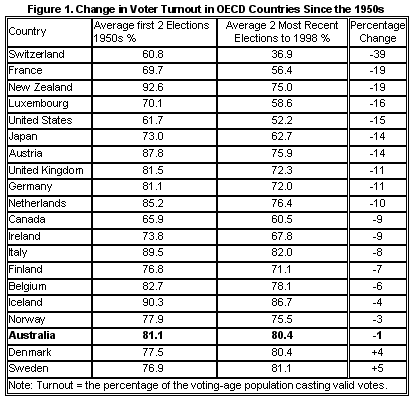There has been much discussion recently about compulsory voting, brought to a focus recently (October 4, 2005) in a speech to the Sydney Institute given by the federal minister responsible for electoral matters, Senator Eric Abetz. The Australian’s Mike Steketee gives a good rundown of the machine politics here.
As much as some politicians would like to make voting voluntary in Australia, the fact that pollster Gary Morgan found that 71 per cent of Australians support compulsory voting, a level that has been maintained for the past 40 years, means the obligation to vote is deeply set into the Australian psyche. Certainly John Howard is not game to take the Australian people on over this.
But what difference does compulsory voting make? Do we vote in greater numbers than comparable countries where voting is voluntary, and are we better informed about the candidates and issues? This paper takes a brief look at some international comparisons and finds the answer to both these questions is “yes” but to a lesser degree than perhaps some may expect.
Advertisement
Voter turnout
A comparative study by Martin Wattenberg from the University of California shows that, in a range of OECD countries, turnout in 1998 was the lowest recorded in the post-war period. Figure 1 illustrates a decline that according to Wattenberg, “is rare in comparative politics to find a trend that is so widely generalizable.”

But my view is that things are not as bad everywhere as many writers might portray. Figure 2 presents the 1998 data in chart form and it can be seen that most of the countries are either on or above the OECD mean of 70.1 per cent.

And 70 per cent for any country is, I think, pretty good - particularly when you are asking people to do something for which they receive no discernable benefit to the individual except a warm inner glow. Much of the bad press comes from the United States of America and Canada where rates are low and that seems to have unduly influenced the literature. Figure 3 gives a breakdown of the most recent Australian federal election held in 2004.

Advertisement
The first thing it tells us is that 15 per cent of the eligible population do not even enroll to vote. Then we lose another 5 percent on ballot day because that number, even though enrolled, fail to attend a voting booth. After we allow for 4 per cent lost to informal voting, we are down to three quarters of the eligible population actually lodging a valid vote on election day. John Howard’s conservatives were therefore elected by 39 per cent of the adult population (52 per cent of 76).
My observation is that compulsory voting makes a difference to turnout, but not as much as many people think. Compulsory voting gives a relatively high level of informal votes (most countries have levels well below 1 per cent), which brings Australia back to the pack even more. After informals are removed, Australia’s “true” participation rate is about 76 per cent, which is not that far above the OECD mean of 70 per cent.
Voter knowledge
So, if a legal compulsion to vote is not the prime motivator, why do large portions of the world’s population bother? There is plenty of evidence that voters around the world are ignorant of politics and politicians, so it can’t be any great public interest in the policy debates. Again it is interesting to compare the US with Australia. Figure 4 summarises some recent findings in the US in regard to voter knowledge. It shows that American voters tend to be ignorant on even the most basic of issues.
Discuss in our Forums
See what other readers are saying about this article!
Click here to read & post comments.
16 posts so far.